Interlaced Up and Down Buttonhole
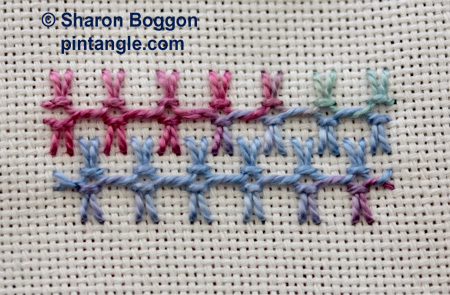
Interlaced Up and Down Buttonhole is an interesting variety of buttonhole that consists of two rows interlaced, as you work them back to back. It forms a really attractive band that is ideal to use on a border, a seam decoration on a crazy quilt or if you work it row upon row, it makes a very nice fill too. You can also add beads for extra zest.
How to work Interlaced Up and Down Buttonhole Stitch
You need to be familiar with Up and Down buttonhole stitch to work this. You first work a row of up and down buttonhole stitch, then the interlacing is done on the second row.
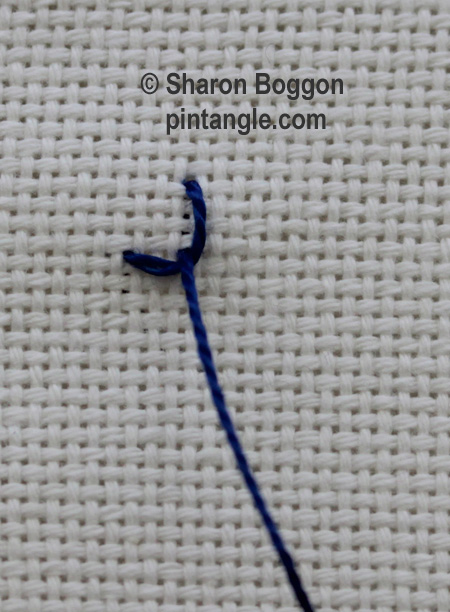 Starting as you would with buttonhole, work the first stitch of the pair as a regular buttonhole stitch, with your needle pointing downwards, wrap the thread under the needle and pull the needle through.
Starting as you would with buttonhole, work the first stitch of the pair as a regular buttonhole stitch, with your needle pointing downwards, wrap the thread under the needle and pull the needle through.
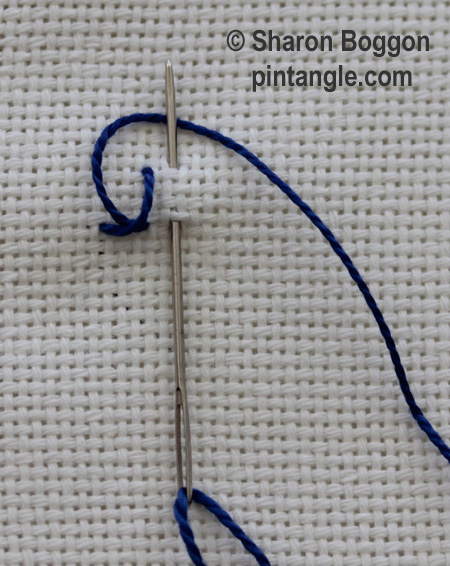 For the second part of the stitch, insert the needle and take a bite of the fabric so that the tip of the needle is pointing upwards as illustrated.
For the second part of the stitch, insert the needle and take a bite of the fabric so that the tip of the needle is pointing upwards as illustrated.
Wrap the working thread under the needle and pull the needle through the foundation fabric. As you pull the needle through, pull the needle towards you instead of away from you. As you do this, hold down the loop that forms with the left thumb to prevent it slipping. The loop forms as you stitch.
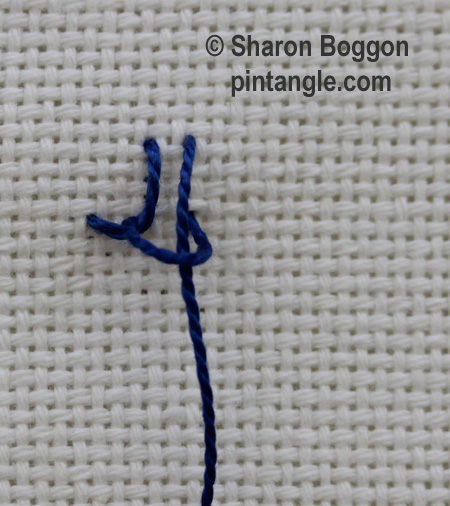 Note I have noticed online that some instructions create a loop then lace the working thread through the stitch. This is wrong the loop is created as you stitch and once you have the rhythm of the stitch it is easy and quick to do.
Note I have noticed online that some instructions create a loop then lace the working thread through the stitch. This is wrong the loop is created as you stitch and once you have the rhythm of the stitch it is easy and quick to do.
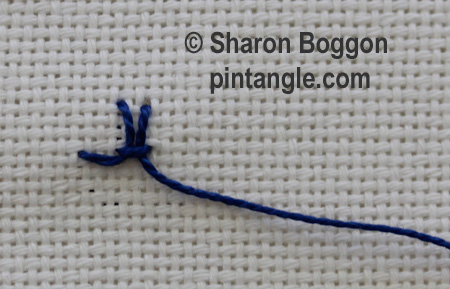 This loop forms the bar at the base of both stitches. This forms the first pair of tied stitches.
This loop forms the bar at the base of both stitches. This forms the first pair of tied stitches.
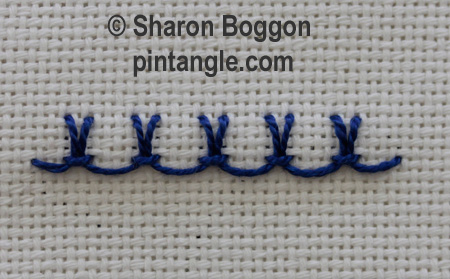 Work along the line.
Work along the line.
Turn your work.
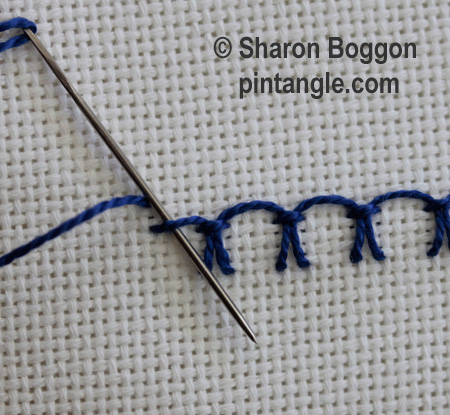
The Second Row
To commence the second row bring your needle from the back so that the thread emerges just above the line of the first row.
Thread the needle under the first bar on the first row, that you have just created. At this stage you are going under the thread, but not through the fabric.
Pull the needle through.
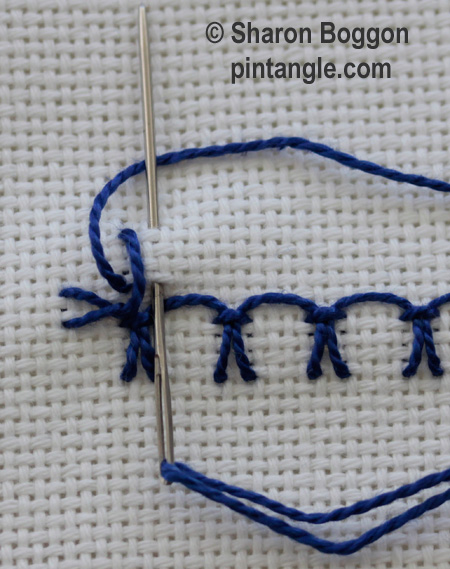 Work a pair of up and down buttonhole stitches.
Work a pair of up and down buttonhole stitches.
 Thread your needle under the next bar and work a pair of up and down buttonhole stitches.
Thread your needle under the next bar and work a pair of up and down buttonhole stitches.
 Continue along the line threading your working thread under each that is between each pair of stitches on the bottom row.
Continue along the line threading your working thread under each that is between each pair of stitches on the bottom row.
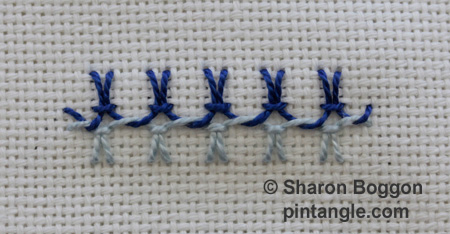 I have worked the two rows in different colours so readers can see how the two rows are laced together. As you can see you could incorporate beading with this stitch very easily.
I have worked the two rows in different colours so readers can see how the two rows are laced together. As you can see you could incorporate beading with this stitch very easily.
Have you seen my Stitchers Templates?
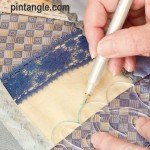
As someone who loves crazy quilting and embroidery, I designed these templates with other stitchers in mind. With my templates, you can create hundreds of different patterns to apply to your stitching and crazy quilting projects. They are easy to use, totally clear so you can position them easily and they are compact in your sewing box.
To see what they look like, find out about the free ebook of patterns that come with them, go to the Pintangle shop .
![]() Follow Pintangle and have it delivered to your inbox
Follow Pintangle and have it delivered to your inbox
You can have Pintangle delivered to your inbox by using the ‘follow’ feature in the sidebar. Just enter your email address, and when you get the confirmation email make sure you say yes and you are all set!
If you are on a mobile or tablet you will need to scroll to the bottom to find the follow feature.



My trials of this stitch are here.
http://hobbysewing.blogspot.com/2020/09/tast-22-beyond-tast-22.html.
Thankyou
This is a great, great stitch!
http://queeniepatch.blogspot.jp/2014/09/tast-128-interlaced-up-and-down.html
Yes Queenie I enjoyed it too!
This stitch looks great, I’m looking forward to give it a try. Today I wrote about a CQ birthday card with TAST stitches, a great excuse to try TAST stitch 127 on rickrack!
http://fat-quarter.blogspot.nl/2014/09/blue-birthday-card.html
Hi Annet I took a look a look at your your aunts birthday card I like the buttonholed cable chain on it. I am sure she will love it too
Fun stitch. I’ve posted my samples at
https://crazyqstitcher.wordpress.com
Great stitch! I like it with the single color and two. Perfect to build upon with other stitches too! I guess I need to find a place to post pix one of these days.
Thanks, Sharon
Thanks for the instructions Sharon. This is an interesting stitch. My sample isn’t all that great but with practice I will get it. http://princessbubblescreates.blogspot.ca/2014/09/take-stitch-tuesday.html
I look forward to trying this stitch out! Your examples are gorgeous.
I completed the beaded alternating up and down buttonhole stitch this week. http://monkeyandmutt.blogspot.com/2014/09/tast-09022014.html